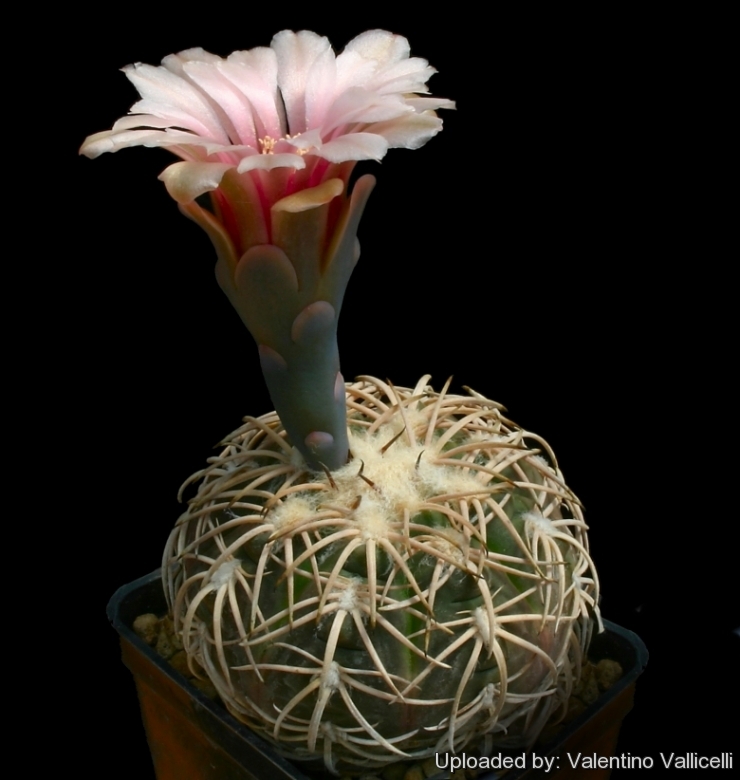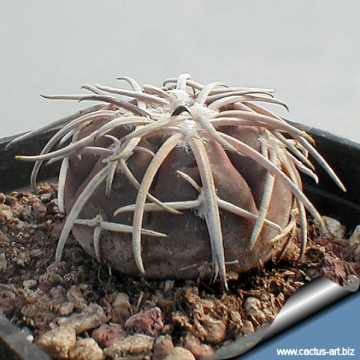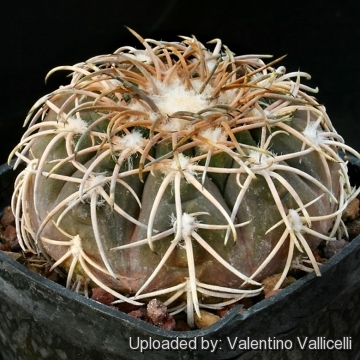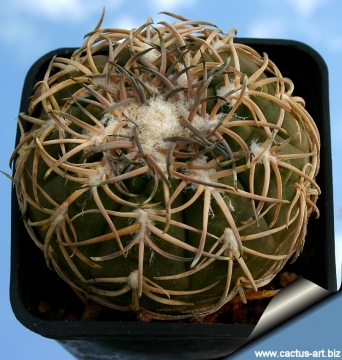Accepted Scientific Name: Gymnocalycium spegazzinii Britton & Rose
Cactaceae (Britton & Rose) 3: 155. 1922 [12 Oct 1922] Remarks: nom. nov. for Echinocactus loricatus Speg. 1905 (later¹homonym, non Poselger 1853). Britton & Rose

Gymnocalycium spegazzinii var. punillense Photo by: Valentino Vallicelli
VS79 (Collector: Vladimír Šorma) Locality: El Obelisco, Salta, Argentina, altitude 1600m. This species is considered one of the most desirable of the Gymnocalyciums, it has a dark brown to almost black body, nicely recurved spines, pink flowers.
Origin and Habitat: Named after its habitat in La Punilla (Argentina, Prov. Salta, Rio de Los Conchas)
Type Locality: Argentina, Prov. Salta, Tal des Rio Las Conchas, La Punilla, 1670 m
Synonyms:
See all synonyms of Gymnocalycium spegazzinii
back
Accepted name in llifle Database:Gymnocalycium spegazzinii Britton & RoseCactaceae (Britton & Rose) 3: 155. 1922 [12 Oct 1922] Remarks: nom. nov. for Echinocactus loricatus Speg. 1905 (later¹homonym, non Poselger 1853).Synonymy: 15
Accepted name in llifle Database:Gymnocalycium spegazzinii subs. cardenasianum (F.Ritter) R.Kiesling & D.MetzingDarwiniana 34(1-4): 404 (1996)Synonymy: 2
Cultivars
(1):
back
Description: Gymnocalycium spegazzini var. punillense is a beautiful slow- growing plant with a noticeably flattened dark brown to almost black body. It is easy to grow. Will not offset. The spines are typically recurved, add-pressed against the body, and most attractive.
Flowers: Pink, produced in late spring, they remain open for up to twelve days.
Subspecies, varieties, forms and cultivars of plants belonging to the Gymnocalycium spegazzinii group
 Gymnocalycium cardenasianum cv. Japanese Selection: has long, stout spines, eagle claw-shaped, typically-twisted, up to 4 cm long. Black turning dark grey as they ages. It has been selected in Japan.
Gymnocalycium cardenasianum cv. Japanese Selection: has long, stout spines, eagle claw-shaped, typically-twisted, up to 4 cm long. Black turning dark grey as they ages. It has been selected in Japan. Gymnocalycium cardenasianum cv. Japanese Selection f. cristatum: is a beautiful crested form with stout black spines typically-twisted, eagle claw-shaped, up to 4 cm long. It has been selected in Japan.
Gymnocalycium cardenasianum cv. Japanese Selection f. cristatum: is a beautiful crested form with stout black spines typically-twisted, eagle claw-shaped, up to 4 cm long. It has been selected in Japan. Gymnocalycium spegazzinii Britton & Rose: is a flattened solitary cactus with very characteristic spines pointing sideways or downward. Distribution: North Argentina on hight altitude and Bolivia.
Gymnocalycium spegazzinii Britton & Rose: is a flattened solitary cactus with very characteristic spines pointing sideways or downward. Distribution: North Argentina on hight altitude and Bolivia.- Gymnocalycium spegazzinii subs. armatum (F.Ritter) Halda & Šorma
 Gymnocalycium spegazzinii subs. cardenasianum (F.Ritter) R.Kiesling & D.Metzing: is densely covered with incredibly strong twisted spines up to 6cm long, pointing sidewards and downward. Usually whitish or pale brown. Distribution: Bolivia (Tarija and Chuquisaca).
Gymnocalycium spegazzinii subs. cardenasianum (F.Ritter) R.Kiesling & D.Metzing: is densely covered with incredibly strong twisted spines up to 6cm long, pointing sidewards and downward. Usually whitish or pale brown. Distribution: Bolivia (Tarija and Chuquisaca). Gymnocalycium spegazzinii var. horizonthalonium Backeb.: is characterized by a variability in the length and shape of the spines and has received many names, leading to confusion with the entirely dissimilar Echinocactus horizonthalonius.
Gymnocalycium spegazzinii var. horizonthalonium Backeb.: is characterized by a variability in the length and shape of the spines and has received many names, leading to confusion with the entirely dissimilar Echinocactus horizonthalonius. - Gymnocalycium spegazzinii var. major Backeb.
 Gymnocalycium spegazzinii var. punillense H.Till & W.Till: The spines are typically recurved, add-pressed against the body, pointing downward and most attractive. Distribution: La Punilla (Argentina, Prov. Salta, Rio de Los Conchas)
Gymnocalycium spegazzinii var. punillense H.Till & W.Till: The spines are typically recurved, add-pressed against the body, pointing downward and most attractive. Distribution: La Punilla (Argentina, Prov. Salta, Rio de Los Conchas) Gymnocalycium spegazzinii subs. sarkae Halda & Milt: with different seeds, darker purple-brown epidermis and long spidery spines. Distribution: Argentina, Salta, San Felipe – La Angostura.
Gymnocalycium spegazzinii subs. sarkae Halda & Milt: with different seeds, darker purple-brown epidermis and long spidery spines. Distribution: Argentina, Salta, San Felipe – La Angostura. Gymnocalycium spegazzinii var. unguispinum Slaba: has only 5 short spines less than 1 cm long, stout, subulate, eagle claw-shaped, typically-twisted and curved gracefully outward and downward. Distribution: South of Puerta Tastil, Salta, Argentina.
Gymnocalycium spegazzinii var. unguispinum Slaba: has only 5 short spines less than 1 cm long, stout, subulate, eagle claw-shaped, typically-twisted and curved gracefully outward and downward. Distribution: South of Puerta Tastil, Salta, Argentina.
Bibliography: Major references and further lectures
1) Edward Anderson “The Cactus family” Timber Press, Incorporated, 2001
2) James Cullen, Sabina G. Knees, H. Suzanne Cubey "The European Garden Flora Flowering Plants: A Manual for the Identification of Plants Cultivated in Europe, Both Out-of-Doors and Under Glass" Cambridge University Press, 11/Aug/2011
3) David R Hunt; Nigel P Taylor; Graham Charles; International Cactaceae Systematics Group. "The New Cactus Lexicon" dh books, 2006
4) N. L. Britton, J. N. Rose “The Cactaceae. Descriptions and Illustrations of Plants of the Cactus Family.” Volume 4, The Carnegie Institution of Washington, Washington 1923
5) Curt Backeberg “Die Cactaceae: Handbuch der Kakteenkunde” Gustav Fischer Verlag, Stuttgart New York 1982–1985
6) John Borg “Cacti: a gardener's handbook for their identification and cultivation” Blandford P., 1970
 Gymnocalycium spegazzinii var. punillense Photo by: Cactus Art
Gymnocalycium spegazzinii var. punillense Photo by: Cactus Art Gymnocalycium spegazzinii var. punillense Photo by: Valentino Vallicelli
Gymnocalycium spegazzinii var. punillense Photo by: Valentino Vallicelli Gymnocalycium spegazzinii var. punillense Photo by: Cactus Art
Gymnocalycium spegazzinii var. punillense Photo by: Cactus ArtSend a photo of this plant.The gallery now contains thousands of pictures, however it is possible to do even more. We are, of course, seeking photos of species not yet shown in the gallery but not only that, we are also looking for better pictures than those already present.
Read More... Cultivation and Propagation: Gymnocalycium spegazziniiSN|996]]SN|996]] is a summer grower species that is easy to cultivate.
Growth rate: It is a slow growing and easily flowering species.
Soils: It likes very porous standard cactus mix soil. Prefer a low pH compost, avoid substrata rich in limestone; otherwise growth will stop altogether.
Repotting: This plant needs plenty of space for its roots, repotting should be done every other year or when the it has outgrown its pot. Use pot with good drainage.
Watering: Needs moderate to copious waterings in summer, but do not overwater (Rot prone), keep dry in winter at a minimum temperature of 0°C.
Fertilization: Feed with a high potassium fertilizer in summer.
Hardiness: Reputedly resistant to frost if kept on the dry side prior to, and during, cold weather (hardy to -12 C ° C, or less for short periods), but for safe cultivation it is best to avoid freezing temperatures.
Exposition: The plant tolerates extremely bright situations but enjoys filtered sunlight or afternoon shade, inside it needs bright light, and some direct sun. Tends to bronze in strong light, which encourages flowering and heavy spine production, but is likely to suffer from sun scorch or stunted growth if over exposed to direct sunlight during the hottest part of the day in summer.
Uses: It is an excellent plant for container growing. It always looks good and stays small. It look fine in a cold greenhouse and frame or outdoor in a rockery.
Pests & diseases: It may be attractive to a variety of insects, but plants in good condition should be nearly pest-free, particularly if they are grown in a mineral potting-mix, with good exposure and ventilation. Nonetheless, there are several pests to watch for:
- Red spiders: Red spiders may be effectively rubbed up by watering the plants from above.
- Mealy bugs: Mealy bugs occasionally develop aerial into the new growth among the wool with disfiguring results, but the worst types develop underground on the roots and are invisible except by their effects.
- Scales: Scales are rarely a problem.
- Rot: This species is particularly easy and accommodating, seldom suffer of cryptogamic diseases. Rot it is only a minor problem with gymnocalyciums if the plants are watered and “aired” correctly. If they are not, fungicides won't help all that much.
Propagation: Division, direct sow after last frost. Seeds germinate in 7-14 days at 21-27° C in spring, remove gradually the glass cover as soon the plants will be well rooted (ca 1-2 weeks) and keep ventilated, no full sun for young plants! To make a cutting twist off a branch and permit it to dry out a couple of weeks, lay it on the soil and insert the stem end partially into the soil. Try to keep the cutting somewhat upright so that the roots are able to grow downward.














